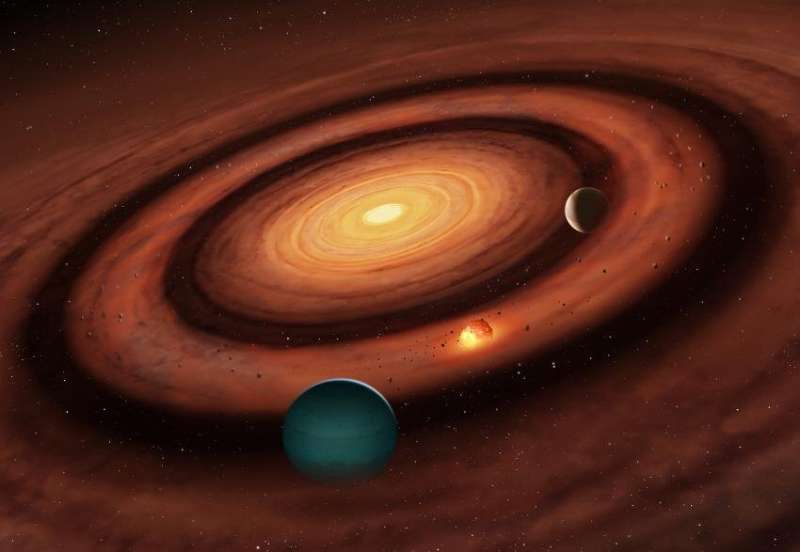‘Sandwich’ discovery offers new explanation for planet formation

Scientists have made a new discovery on how small planets might form. Researchers at the University of Warwick investigated the “birth environment” of planets—areas of gas and dust that swirl around a central star—known as the protoplanetary disk.
They discovered a new method of planet formation in this region, not yet described in previous research. The work has been submitted to the journal Monthly Notices of the Royal Astronomical Society and is showcased at the National Astronomy Meeting, which begins today, Monday 3 July. The team showed how two large planets in the protoplanetary disk can potentially give rise to a smaller planet in between them—which they term “sandwiched planet formation.”
The reason for this is that the two original, large planets restrict an inwards flow of dust. This means that the amount of dust that collects between them is reduced compared to if there were no outer planet. If that dust was to eventually come together to form a planet, then the middle planet would likely be smaller than the outer two planets—like the filling of a sandwich.
While further research is needed in the field, this theory could present a possible explanation for the formation of small planets; like Mars and Uranus, which are each surrounded by larger planets.
Associate Professor and Dorothy Hodgkin Fellow, Farzana Meru, from the Department of Physics at the University of Warwick, said, “In the last decade, observations have revealed that rings and gaps exist in protoplanetary disks. The gaps are where we expect planets to be, and we know from theory work that planets cause dust rings to form just exterior to them. What exactly is happening in those rings poses an important question to astronomers around the world.
“In our study, we propose the rings as sites of planet formation; specifically, that there are sandwiched planets currently being formed in those rings. This is very different to the conventional view of planet formation, where we typically expect that the planets form sequentially from the inside to the outside of the disk and get more and more massive further out. What is also really interesting is that there are examples that we have found from exoplanet observations that actually show this sandwiched planet architecture—where the middle planet is less massive than its neighbors; it is a reasonable proportion of the systems too.
“The field of planet formation has been revolutionized recently. High-resolution images of planet-forming disks have come out in the last ten years since a new sophisticated telescope (the Atacama Large Millimeter/submillimeter Array) started observing the night sky. These images have given us clues about how planets form and evolve; it’s exciting to be at the forefront of this research.”
Citation:
‘Sandwich’ discovery offers new explanation for planet formation (2023, July 3)
retrieved 4 July 2023
from https://phys.org/news/2023-07-sandwich-discovery-explanation-planet-formation.html
This document is subject to copyright. Apart from any fair dealing for the purpose of private study or research, no
part may be reproduced without the written permission. The content is provided for information purposes only.
For all the latest Science News Click Here
For the latest news and updates, follow us on Google News.

